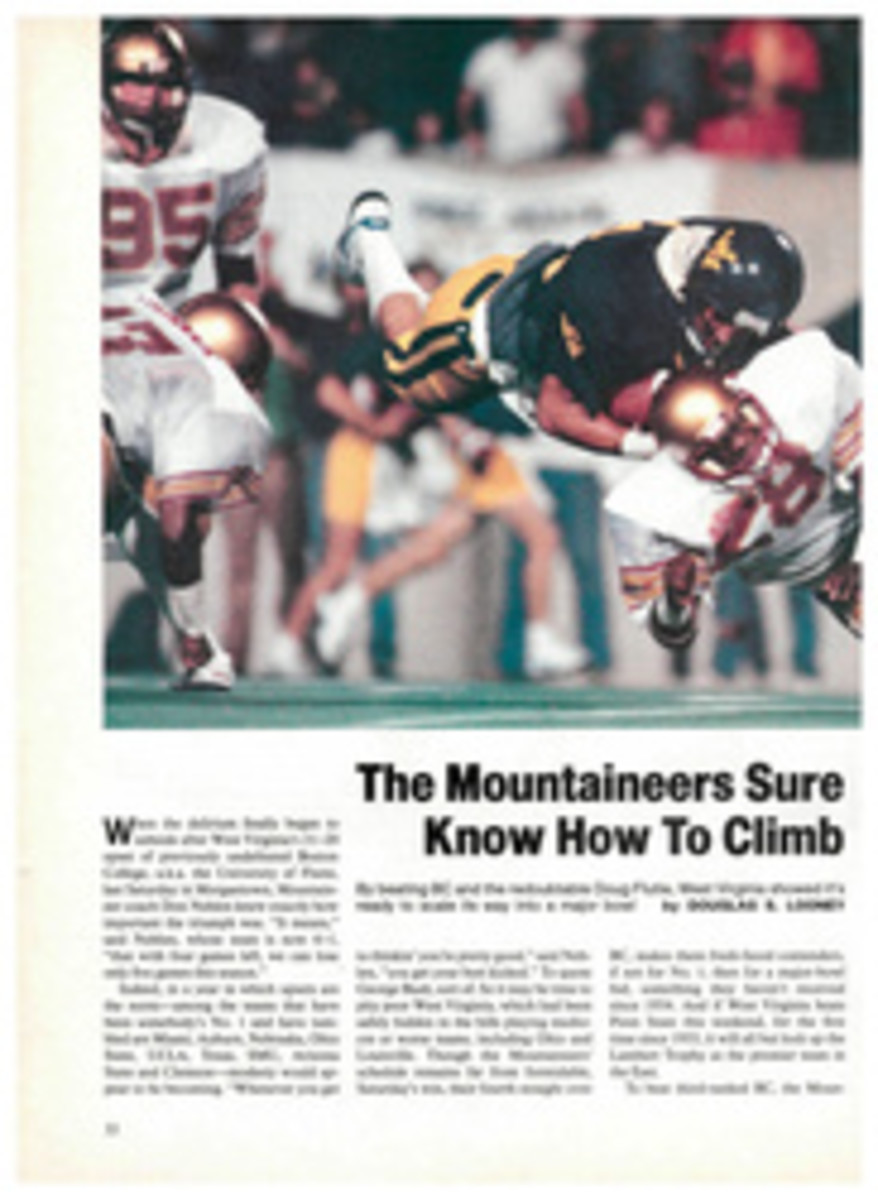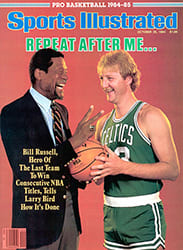
Black day for Notre Dame
Before Joe Morrison rode into Columbia, S.C. last year and started painting the town black, the University of South Carolina was a byword for college football mediocrity. Going into this season, in fact, the Gamecocks were exactly .500 (386-386-37) over 90 mostly ho-hum years pleasantly interrupted only by George Rogers's winning of the Heisman Trophy in 1980. Other highlights? Two appearances and two losses in the Gator Bowl, and a visit apiece to, and defeats in, the Hall of Fame, Peach and Tangerine bowls. Over the years the Gamecocks have been distinguished principally by a tendency to pay huge settlements to fired coaches in an eternal search for a savior.
Well, they may finally have one in Morrison, the 47-year-old Old Dependable of the New York Giants from 1959 through '72. Morrison's Gamecocks ran their season record to 6-0 last Saturday in South Bend with a 36-32 victory over Notre Dame's Dying Irish. South Carolina's best start ever has made the Gamecocks No. 13 in the SI poll, and one cockeyed optimist, a mathematics professor from Penn State named Thomas Jech, even ranks them Numero Uno.
South Carolina isn't that good yet, but it is good. The Notre Dame game was the Gamecocks' first on the road, and they were gutty enough to score three touchdowns in the fourth period to erase a 26-14 deficit. True, they've caught Pitt and the Irish in bad years, but they've also beaten Georgia. And they have the stuff—a well-run veer offense and a swarming, pursuit-oriented defense that calls itself the Fire Ants—to beat both Florida State (at home on Nov. 10) and Clemson (away on Nov. 24), the major hurdles remaining on their schedule.
At this point, then, South Carolina is a good bet for a major bowl bid. It doesn't have a marquee name aside from Morrison's, but it does have a faithful following. Any bowl official's interest would have been whetted had he been in Columbia last Saturday evening when more than 10,000 screaming fans jammed the airport to greet their returning heroes.
Among the signs at the celebration was one that read BLACK MAGIC, a reference to the fashion trend that Morrison has inadvertently unleashed in Columbia. It began last season, when he wore an all-black outfit at his debut against North Carolina; though the Gamecocks lost 24-8, Morrison's garb won the fans' attention. "It was clean and it fit," says Morrison of his outfit. He kept on wearing basic black, and dark sunglasses, to all games and practices. Of course, now that South Carolina is a big winner, he wouldn't dream of changing. The fans have come to regard the overall effect of his attire as one of strength and mystery, and they have followed suit, so to speak. "There's nothing on the racks in black," says D.H. (Jeff) Jefcoat, manager of the Sears in Columbia. "Black shirts, black caps, black pants. They're all gone."
Morrison could have strolled the sideline in a pink tutu during his years at New Mexico (1980-82) and it wouldn't have made much difference. The Lobos went 10-1 in 1982, but neither the bowls (New Mexico went bidless) nor the fans (attendance averaged only 23,000) seemed to notice. "I wouldn't exactly say I was looking for a new job," said Morrison, "unless, of course, something came along."
South Carolina's offer wasn't the only something. On the December evening in 1982 on which Gamecock athletic director Bob Marcum called Albuquerque, Morrison was having dinner with representatives from Tulane. "Tell Joe not to do anything foolish," Marcum told Morrison's wife, JeVena. That's exactly what Marcum had done the year before, when he hired Richard Bell to replace Bell's old boss, Jim Carlen, who had been sent packing after seven seasons. Bell went 4-7. South Carolina has paid Carlen $506,800 in cash and insurance, the cost of buying out the rest of his five-year contract. It has also paid Bell $171,000 plus $7,000 in legal fees, the result of his having won a breach of contract suit against the university in federal court. The ever-optimistic Marcum gave Morrison a five-year contract, and even extended it a year after his 5-6 '83 season.
Morrison's methods reflect the same unselfish attitude with which he himself played. He plays two quarterbacks, sending Mike Hold in for starter Allen Mitchell "when I have a feeling," as he did against Notre Dame; alternates four running backs, and rotates 14 to 18 different players along his defensive front seven.
Midway through the third period in South Bend, with Notre Dame leading 26-14, Morrison felt it was time to put the offense on Hold, whose entry coincided with the onset of an Irish famine that lasted well into the fourth quarter. Four Irish drives finished punt, interception, punt, fumble. Meanwhile, Hold led the Gamecocks to three touchdowns, scoring the second on a mad 33-yard scramble despite a right knee he'd banged up a few plays earlier. South Carolina's final touchdown, a four-yard pickup by Quinton Lewis, gave the Gamecocks a 36-26 lead with seven minutes left, and in the next moments the sense of one school on the rise, the other in decline, was inescapable. While Lewis held his arms aloft before a delirious bloc of South Carolina fans—more than 5,000 made the trip—Notre Dame coach Gerry Faust stood on the sidelines, looking upward at a steady, cold rain falling from a you-know-what-kind of October sky.
South Carolina's quartet of running backs isn't the Four Horsemen, but it will do. Lewis, the only senior, may be the least talented but he's averaging 7.1 yards per carry. Sophomore Raynard Brown has 4.52 speed and pound for pound is also the strongest Gamecock. Junior Thomas Dendy seems content even though the platoon system—he had only eight carries for a net of 26 yards against Notre Dame—means he can't maintain the pace that had him close to Rogers (1,573 yards to 1,629) after two seasons.
The best of the lot might be junior Kent Hagood, who at a solid 215 pounds and with 4.6 speed would be a bruising Keith Byars-type tailback in a power-I. He gained 89 yards on 16 carries against the Irish and is averaging 6.4 per carry for the season. When Hagood arrived on campus in the fall of 1981, Carlen called him "the next George Rogers," but by January of '82 the next George Rogers had quit school and was working as a press operator at a J.P. Stevens mill in Greenville. "I was sitting around watching television with my little nephew one day when I heard a car door slam and saw this big, tough-looking guy get out all dressed in black," Hagood recalls. "I said to my nephew, 'Yeah, that must be the man.' He asked me back and I'm glad I came."
Morrison has a similar effect on most everyone he meets. He's a man of few words, but he has a directness and a sense of purpose about him. The veer offense fits him. It's quick-hitting and basic but lends itself to passing in a way that its cousin, the wishbone, doesn't. Morrison's "veer man" is Frank Sadler, who has followed Morrison from Tennessee-Chattanooga to New Mexico to South Carolina. "We believe in the veer here," says Sadler. "We'll be in it till we die off."
Talk about dying, that's what the Gamecocks, who probably do as much running in practice as any team in the nation, feel like they're going to do much of the time. Under Morrison, every defensive player must be either in on a tackle or running full-speed toward the play by the time the film camera clicks off, both in practice and games. "If they switched me to defense," says offensive guard Del Wilkes, "I'd think about suicide." The term Fire Ants was coined by defensive coordinator Tom Gadd one day as he watched film of his defense, in their home garnet jerseys and pants, swarming around a ballcarrier. The best of the Ants is linebacker James Seawright, a possible first-round draft choice who leads South Carolina with 58 tackles, 11 of them against Notre Dame.
But Morrison doesn't have many James Seawrights. What he has are a lot of Joe Morrisons—players who are tough and consistent, qualities the Giants recognized when they retired Joe's No. 40 jersey after his 14-year New York career. South Carolina fans already have a feeling they'll have cause to similarly treat his whole black ensemble one day.
PHOTO
HEINZ KLUETMEIER
Allen Pinkett scored two TDs, but the Irish still were dumped by South Carolina's D.
PHOTO
HEINZ KLUETMEIER
Despite his garb, Morrison has shone brilliantly as a coach.
PHOTO
HEINZ KLUETMEIER
Hold (7) sneaked in for this, his first TD, ran in for a second and handed off for a third.

